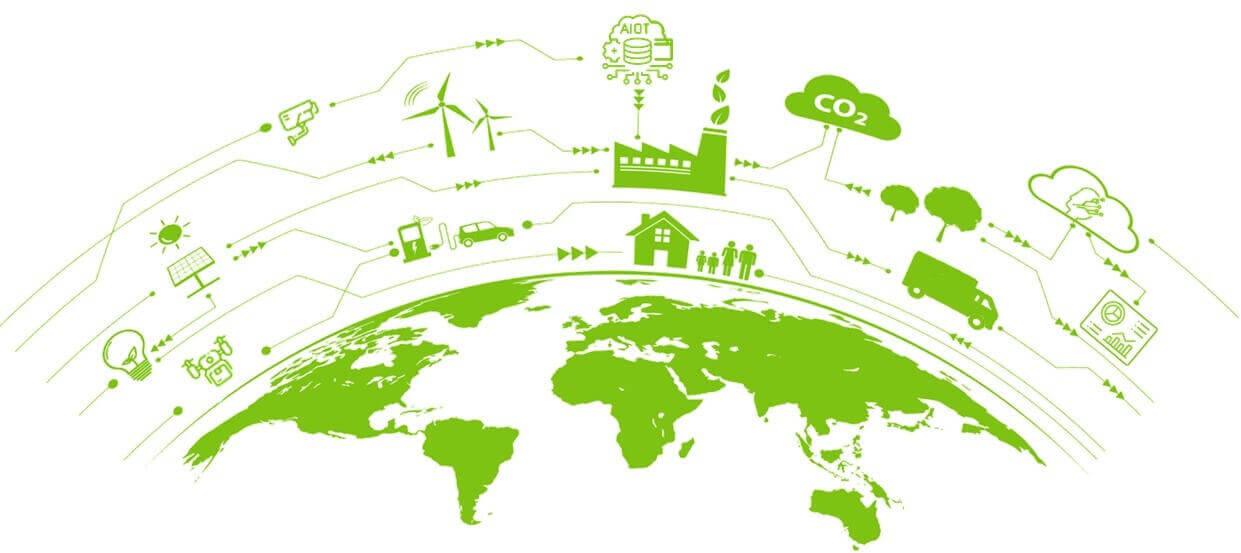Jul27

Today, sustainability is critical for businesses of all sizes and industries. Investors expect companies, clients and regulators to take a proactive approach to sustainability, setting ambitious goals and implementing strategies to reduce their environmental impact and promote social responsibility. Achieving this in most industries is only possible with AI0T.
The fusion of two powerful and transformative technologies, Artificial Intelligence (AI) and the Internet of Things (IoT), has given birth to an innovative concept known as AIoT. This convergence is anticipated to revolutionise our daily living and working patterns.
IoT, the Internet of Things, comprises a network of physical devices, appliances, vehicles, and other items. These elements are embedded with sensors, software, and connectivity attributes that enable them to collect and exchange data, painting a picture of a highly interconnected digital landscape.
On the other hand, AI, or artificial intelligence, encapsulates the capacity of machines to learn and execute tasks typically requiring human intelligence. It represents a leap towards creating devices capable of simulating cognitive processes.
AIoT elevates the capabilities of IoT, integrating AI algorithms and machine learning models within the IoT network's devices and systems. This integration empowers the devices to amass and transmit data and analyse and interpret it in real-time, enhancing their intelligence and responsiveness.
For instance, an AIoT-enabled smart thermostat could learn the temperature preferences of its users and adjust the heating and cooling accordingly. This would result in energy savings and significantly improve comfort levels.
In the context of sustainability, the application of AIoT (Artificial Intelligence of Things) emerges as a significant game changer. The key to its profound impact lies in its ability to revolutionise resource utilisation efficiency.
To fully grasp the transformative potential of AIoT, it is crucial to delve into the specifics of its application across various sectors. By examining its use in unique scenarios, we can illuminate the depth and breadth of its capabilities.
Artificial Intelligence of Things (AIoT) plays a significant role in energy efficiency. Its integration with renewable energy systems and IoT devices enables it to optimise performance, reduce energy waste, and boost the utilisation of clean energy sources. These capabilities provide positive environmental impacts and assist organisations in achieving their sustainability objectives.
One of the key ways through which AIoT contributes to sustainability is by enhancing energy efficiency. AIoT systems analyse data obtained from IoT devices, such as smart thermostats, lighting systems, and appliances, to identify patterns in energy usage. These intelligent systems then make informed adjustments to reduce waste. For instance, an AIoT system could discern that a specific room in a building is consistently overheated and adjust the thermostat settings accordingly. Over time, these incremental adjustments compound, leading to significant energy savings.
Beyond IoT devices, AIoT also optimises the performance of renewable energy systems. An illustrative example would be an AIoT system analysing data from solar panels to determine the optimal angle and orientation for maximum energy generation. This strategic optimisation ensures renewable energy systems operate at peak efficiency, reducing reliance on fossil fuel-based energy sources.
AIoT plays a significant role in manufacturing that is geared towards sustainability. Through AIoT, a connected ecosystem is created, empowering manufacturers to monitor and control both inputs and outputs of production in real time. This leads to a substantial improvement in efficiencies, considerable energy savings and, consequently, a cost reduction.
Further to this, AIoT also assists manufacturers in optimising their supply chain management. Employing AI algorithms to analyse data collected from IoT sensors enables manufacturers to pinpoint inefficiencies within their supply chain. Once identified, corrective actions can be taken. The benefits here are multifaceted, with reductions in transportation costs, waste, and improved delivery times.
One of the central roles of AIoT in sustainable manufacturing is its capacity for predictive maintenance. By utilising AI algorithms to sift through data from IoT sensors, manufacturers can forecast potential equipment failures and take proactive measures to prevent costly downtime. This leads to a reduction in maintenance costs, a boost in equipment reliability, and a minimisation of waste. In addition, this technological blend aids in optimising energy consumption by automatically adjusting equipment settings based on real-time data collected from IoT sensors.
An often overlooked benefit of AIoT is its potential to enhance product design. Manufacturers can develop more sustainable products that meet customer needs and minimise environmental impact by analysing customer feedback and usage data. This signifies a strategic step towards sustainability while maintaining a strong focus on customer satisfaction.
Unprecedented technological advancements, particularly in Artificial Intelligence of Things (AIoT), can be a game changer for sustainable smart agriculture. Integrating these two technologies can optimise crop yields while simultaneously minimising resource usage, promoting sustainability in agriculture.
AIoT plays a key role by collecting and analysing data from sensors and other Internet of Things (IoT) devices. Artificial intelligence (AI) algorithms can provide critical insights into the health and growth of crops. This empowers farmers to make informed irrigation, fertilisation, and pest control decisions. The result is improved efficiency, reduced waste, and conservation of natural resources such as water and soil nutrients.
Furthermore, AIoT can considerably reduce agriculture's environmental impact by enabling precision farming techniques. Using AI algorithms to analyse data collected from sensors and drones allows farmers to identify specific areas of their fields that require more or less attention. This targeted approach enables more effective resource allocation, significantly reducing the use of pesticides and fertilisers, which are known to harm the environment. Notably, this approach also reduces the amount of fuel expended in farming operations.
Another essential contribution of AIoT in sustainable smart agriculture is its role in monitoring and managing livestock. By utilising sensors and other IoT devices to collect data on animal health and behaviour, AI algorithms can help farmers to identify potential health issues before they escalate into serious problems. This proactive approach minimises the need for antibiotics and other medications, which can have negative environmental impacts, and significantly improves animal welfare.
In summary, AIoT can revolutionise sustainable smart agriculture by enabling precision farming techniques and enhancing the monitoring and management of crops and livestock. Its potential to reduce agriculture's environmental impact while improving efficiency and productivity underscores its transformative capacity.
AIoT plays a significant role in sustainable smart buildings by allowing for the creation of intelligent systems that can optimise energy consumption, reduce waste, and enhance the overall efficiency of the building.
Using AI algorithms, intelligent buildings can analyse data collected from various IoT sensors to make informed decisions about energy usage. For example, the system can automatically adjust lighting and temperature based on occupancy and weather conditions, reducing energy consumption and cost savings.
AIoT can also help identify areas of the building that could be utilised more efficiently, such as empty conference rooms or unused office spaces. By analysing data from occupancy sensors, the system can optimise the use of these spaces, reducing the need for additional heating, cooling, and lighting.
Moreover, AIoT can be used to monitor and control water and other resources in the building. The system can detect leaks and other issues by analysing sensor data, allowing for prompt repairs and reducing water waste.
Integrating AI and IoT technologies in smart buildings can significantly improve sustainability, energy efficiency, and cost savings. As such, it is becoming increasingly important for building owners and managers to consider the implementation of AIoT systems in their buildings.
Playing a pivotal role in sustainable waste management, AIoT (Artificial Intelligence of Things) provides real-time data generation, collection, and disposal. By exploiting this information, waste management companies can identify inefficiencies, optimise their operations, and reduce waste, thereby implementing more effective waste management strategies.
Sensors enabled by AIoT can be installed in waste bins to monitor the fill level. This valuable data allows waste management companies to optimise their collection schedules, thus reducing redundant trips. Such an approach conserves time and resources and minimises carbon emissions from collection vehicles, contributing significantly to environmental preservation.
AIoT can also make a substantial difference when sorting and classifying waste, making recycling more efficient. Utilising AI algorithms, different types of trash can be identified and sorted accordingly. This innovative method eliminates the need for manual sorting and enhances the accuracy of the sorting process. Consequently, this leads to higher recycling rates and decreased waste sent to landfills.
With its potential to provide real-time data, optimise operations, increase recycling rates and reduce environmental damage, AIoT is set to revolutionise sustainable waste management, marking a significant step towards a sustainable future.
Artificial Intelligence of Things (AIoT) is a powerful tool for enabling real-time data collection and analysis in sustainable smart transportation. By harnessing AI algorithms, data harvested from various sensors and devices is analysed to identify patterns and formulate predictive outcomes. These insights are crucial in optimising traffic flow, diminishing congestion, and, ultimately, minimising harmful carbon emissions.
The deployment of AIoT also significantly aids the progression of autonomous vehicles. These vehicles, more fuel-efficient and less polluting than their traditional counterparts, can communicate with each other and the surrounding infrastructure. This enables them to make real-time decisions to optimise their performance, reducing environmental impact.
In addition, AIoT can be utilised to create intelligent transportation systems that are more responsive to the needs of commuters. For instance, real-time data on traffic conditions and public transport schedules can be intelligently processed to provide personalised recommendations to commuters. These suggestions offer the most efficient and sustainable modes of transport, enhancing the commuter experience.
In summary, AIoT possesses the potential to revolutionise the transportation sector, making it more sustainable, efficient, and responsive to the needs of commuters. Through leveraging the combined power of AI and IoT, we are on the cusp of creating a transportation system that is not only environmentally friendly but also significantly enhances the quality of life for individuals.
The convergence of the Internet of Things (IoT) and Artificial Intelligence (AI) promises a transformative impact on sustainability efforts, paving the way for a greener tomorrow. The amalgamation of these two revolutionary technologies ushers in an era of unprecedented intelligence and efficiency, contributing to a more sustainable world.
The Power of AIoT: By harnessing the capabilities of AIoT, we can significantly reduce energy consumption, minimise waste, and enhance resource efficiency. These advantages benefit humanity and protect our planet, demonstrating the potential of technology as a force for good.
Implications for Executives: For business leaders, understanding and leveraging AIoT's potential is a strategic necessity. Exploring its applications can drive sustainability within your organisation and beyond, leading to beneficial outcomes for the business and broader society.
By Gert Botha
Keywords: AI, IoT, Sustainability
 Grandad, what's a Supply Chain Planner
Grandad, what's a Supply Chain Planner Operational Speed Without Strategic Clarity Creates Chaos
Operational Speed Without Strategic Clarity Creates Chaos The AI Curriculum: A Library's Deep Dive into Artificial Intelligence
The AI Curriculum: A Library's Deep Dive into Artificial Intelligence Friday’s Change Reflection Quote - Leadership of Change - Change Leaders Serve Future Generations
Friday’s Change Reflection Quote - Leadership of Change - Change Leaders Serve Future Generations The Corix Partners Friday Reading List - November 28, 2025
The Corix Partners Friday Reading List - November 28, 2025